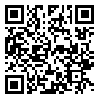Volume 13, Issue 6 (9-2014)
ijdld 2014, 13(6): 487-494 |
Back to browse issues page
Download citation:
BibTeX | RIS | EndNote | Medlars | ProCite | Reference Manager | RefWorks
Send citation to:



BibTeX | RIS | EndNote | Medlars | ProCite | Reference Manager | RefWorks
Send citation to:
Bakhtiyari F, Foroughan M, Fakhrzadeh H, Nazari N, Najafi B, Alizadeh M, et al . VALIDATION OF THE PERSIAN VERSION OF ABBREVIATED MENTAL TEST (AMT) IN ELDERLY RESIDENTS OF KAHRIZAK CHARITY FOUNDATION. ijdld 2014; 13 (6) :487-494
URL: http://ijdld.tums.ac.ir/article-1-5271-en.html
URL: http://ijdld.tums.ac.ir/article-1-5271-en.html
Fariborz Bakhtiyari 
 , Mahshid Foroughan *
, Mahshid Foroughan * 
 1, Hossein Fakhrzadeh
1, Hossein Fakhrzadeh 
 , Neda Nazari
, Neda Nazari 
 , Baharak Najafi
, Baharak Najafi 
 , Mahtab Alizadeh
, Mahtab Alizadeh 
 , Masoud Arzaghi
, Masoud Arzaghi 
 , Farshad Sharifi
, Farshad Sharifi 
 , Shervan Shoaee
, Shervan Shoaee 
 , Qorbani Mostafa
, Qorbani Mostafa 


 , Mahshid Foroughan *
, Mahshid Foroughan * 
 1, Hossein Fakhrzadeh
1, Hossein Fakhrzadeh 
 , Neda Nazari
, Neda Nazari 
 , Baharak Najafi
, Baharak Najafi 
 , Mahtab Alizadeh
, Mahtab Alizadeh 
 , Masoud Arzaghi
, Masoud Arzaghi 
 , Farshad Sharifi
, Farshad Sharifi 
 , Shervan Shoaee
, Shervan Shoaee 
 , Qorbani Mostafa
, Qorbani Mostafa 

1- , foroughanm@gmail.com
Abstract: (18520 Views)
Background: One of the common problems of the elderly, which increase of its prevalence with aging is the dementia and the cognitive impairment. We can help the involved patients to have a better quality of life with early diagnosis of the cognitive impairment. The aim of this study was an assessment of the validity and reliability of the Persian version of the abbreviated mental test (AMT) among the older people in a nursing home setting.
Methods: 176 eligible elderly people aged ≥ 60 years living in KahrizakCharity Foundation (KCF), were selected randomly based on medical record number. Demographic information and past medical history of the participants were collected. Geriatric depression scale 15 (GDS-15), global deterioration scale (GDS) forms and also the Persian version of the abbreviated mental test (AMT) were administered. The participants were assigned to two groups the normal and impaired cognitive groups, based on DSM-IV diagnostic criteria. The GDS cut-points were used for assessment of validity, sensitivity and specificity of the Persian version of AMT.
Results: The mean age of the participants was 77.30 (7.94) years. The Persian version of AMT had good discriminated validity in diagnosis of normal and impaired cognitive participants (7.35 ± 2.33 and 5.99 ± 2.29, P < 0.01 respectively) and at cut-point AMT< 8,(based on GDS cut-point) it had a sensitivity and specificity 92.15 % and 81.50% respectively. The sensitivity and specificity based on theism IVcriteriawere 64.9% and 64.0% at cut-off point equal to 7, respectively. The internal consistency of the Persian version of AMT was acceptable (Cronbach’salpha coefficient =0. 76). As well as the external reliability (intra-rater) of this instrument was good inter-class correlation coefficient (ICC) = 0.89)
Conclusion: The Persian version of the AMT has appropriate validity and reliability in Iranian older people.
Type of Study: Research |
Subject:
General
Received: 2014/11/17 | Accepted: 2014/11/17 | Published: 2014/11/17
Received: 2014/11/17 | Accepted: 2014/11/17 | Published: 2014/11/17
Send email to the article author
| Rights and permissions | |
 |
This work is licensed under a Creative Commons Attribution-NonCommercial 4.0 International License. |



